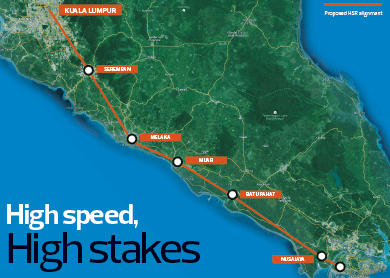
THE 350km route between Kuala Lumpur International Airport and Singapore’s Changi International Airport is among the world’s busiest and most competitive short-distance flight sectors. With seven airlines mounting close to 300 flights a week on this route, the frequency of flights has been increasing to meet growing demand over the decades.
According to Civil Aviation Authority of Singapore’s data, about 6,000 people flew from Changi to Kuala Lumpur daily last year, which translates into more than two million passengers annually.
However, with a high-speed rail (HSR) set to become the new and, presumably, more cost-competitive transport option, the modal share (proportion of travellers using a particular mode of transport) of journeys between KL and Singapore could quickly lean towards the HSR within a decade of operation. This could mean a drop in demand for shuttle flights on this route.
Apart from competitive fares, the HSR offers ease of mobility and punctuality, both of which are a boon for commuters who dread the long queues at airports and flight delays.
There are precedents of HSR projects decimating domestic air routes, as shown by the dramatic shift in modal share in Seoul-Busan travel following the launch of South Korea’s first HSR line spanning 536km (see table). Modal share for air travel between the two cities shrank from 32% in 2003 to 15% in 2012, while rail travel increased from 38% to 69% in the same period.
The shift is even more significant for the 409km journey between Seoul and Daegu, which was the HSR’s first stop before the extension to Busan was completed in 2010. By 2012, the modal share for rail travel jumped sixfold to 60% while air travel became almost non-existent, at just 2%.
Suruhanjaya Pengangkutan Awam Darat has not disclosed the current modal share for travel between Singapore and KL, but it is believed that the modal share for air travel is comparable to that of road travel. If the proposed HSR can replicate what has happened in other countries, air and vehicle traffic could be dramatically reduced within a decade — possibly a grim prospect for airlines in particular.
South Korea’s Ambassador to Malaysia Cho Byungjae says his country’s aviation industry has quickly acknowledged that the HSR would make short-distance air travel less economically feasible.
“Increasing public acceptance of the HSR has resulted in tremendous growth in ridership. The airlines are refocusing on routes of 500km or more as a large part of domestic travel needs are already covered by the rail system,” he adds.
Given that HSR projects typically receive some form of government subsidy, it is fairly easy for rail operators to set fares at or below those of airlines. For example, Taiwan High Speed Rail Corp sets its fares at 75% of prevailing air ticket prices, which effectively forced airlines to abandon the Taiwan-Kaohsiung route within five years the country’s HSR began running.
“We don’t know the pricing for the HSR yet, but it will certainly force airlines to rationalise the frequency of their flights. To be fair, it is far too early to make reasonable assumptions that one of the world’s busiest air links is under threat,” says RHB Research aviation analyst Ahmad Maghfur Osman.
Frost & Sullivan’s aviation consultant Amartya De says the impact would not be far-reaching. “The KLIA-Changi route would only amount to less than 5% of overall seat capacity of AirAsia, so there would not be an alarming change in earnings. Over the next seven years, demand for KL-Singapore air travel is also expected to be 40% higher than what it is today, hence the net impact is not expected to be huge.”
Last month, AirAsia Group CEO Tan Sri Tony Fernandes told an online business publication that while it is hard to gauge the HSR’s impact on airlines presently, the project itself will stimulate economic growth in both countries, thus ultimately benefiting the travel industry as a whole.
Malindo Air CEO Chandran Rama Muthy goes a step further, telling The Edge that there is also the option of making the HSR complementary to the airlines.
“The main objective of the project would be to improve connectivity and reduce traffic congestion, both of which are fantastic goals. You have to remember that passenger volume growth between KL-Singapore remains very strong annually, regardless of the mode of transport, so there are few reasons why rail and air transport cannot be complementary,” he says.
He adds that Malindo Air remains keen on increasing the frequency of its KL-Singapore flights, and that airlines should not be wary of the HSR, given the potential benefits such as increased integration of the different modes of transport.

This article first appeared in The Edge Malaysia Weekly, on June 15 - 21, 2015.
Save by subscribing to us for your print and/or digital copy.
P/S: The Edge is also available on Apple's AppStore and Androids' Google Play.